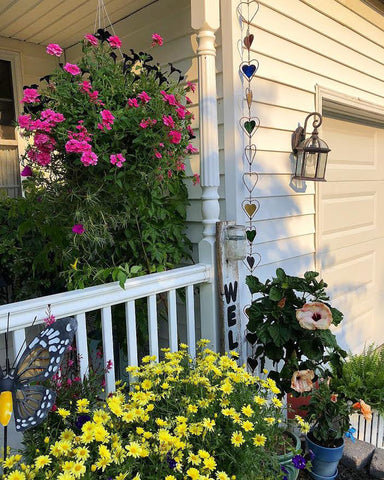Rain chains, wind spinners for gardens, wind chimes, and much more: We love the way garden art transforms our surroundings! But how to protect outdoor items from damage caused by exposure to the elements? Whether you’ve purchased your treasures from Happy Gardens or elsewhere, we’d like to help you learn how to preserve them and help them last longer.
See here for our metal yard art ideas.

Out of interest, here are some of our best selling metal garden products:
Protecting Metal Garden Art

All of our metal products are made of steel with a powder coated finish, which provides protection from the elements while resisting fading, chipping, corrosion, and other signs of wear. While powder coating is long-lasting and much harder than traditional paint, no finish lasts forever! That’s why we recommend that you treat your garden treasures to a coat of clear polyurethane before displaying them, and repeat the process from time to time to keep the finish looking new.
While polyurethane can be applied with a brush, you may find it far simpler to use spray polyurethane, which comes in your choice of matte or glossy finishes. Inexpensive and easy to use, it goes on in seconds and dries quickly. Be sure to follow the manufacturer’s instructions for safety and smooth application.
Quick tips for protecting metal from rust:
- Clean the item with a lint-free cloth, even if it’s brand-new. It’s a good idea to treat your garden art to a quick wipe down with mineral spirits, too. This will remove any residue that might prevent the polyurethane from bonding to the item’s surface.
- Protect your work surface with a dropcloth and lay the item flat.
- Apply one light coat of polyurethane to the exposed surface, and then allow it to dry.
- Flip the item over and apply a light coat of polyurethane to the opposite side.
- Repeat the process a second time for added protection.
- Once all sides have been protected, display your item!
Remember to repeat your polyurethane treatment at least once a year. With a little bit of extra finish and a few minutes of your time, your metal garden art will provide many years of enjoyment. If possible, bring your items in to a temperature-controlled area during freezing weather. They’ll last even longer, and you’ll spend less time maintaining them.
What If I Notice Rust?
Polyurethane clear coats do a great job of preventing rust, but outdoor décor can sometimes be subject to impacts that damage the finish and leave metal exposed to the elements. It’s a good idea to inspect your metal garden art periodically. The sooner you catch damage, the easier it is to repair, and the longer you’ll be able to enjoy your favorite pieces.
There are many ways to get rid of rust. You can try using a commercial rust remover or rust converter, or you can soak your item in white vinegar to dissolve the rust. Once you’ve gotten your item back to bare metal, dry it and apply a protective coat of polyurethane. Be sure to let it dry before exposing your art to the elements.
Protecting Stone, Cement, Ceramic, and Resin Garden Art

Stone, cement, terra-cotta, porcelain, ceramic, and resin are common materials used in garden art, such as stone statues.While these offer quite a bit of durability, they can crack when exposed to freezing temperatures – particularly if they’re damp. Dry them in a protected area before freezing weather arrives, and store them in a temperature-controlled environment if possible.
Resin art is prone to fading. Consider keeping colorful items in an area that receives shade most of the day, or treat them to two coats of polyurethane. Choose a brand with UV protection, which will help keep colors bright. Scrub resin art with soap and water before applying the polyurethane. Let it dry completely before applying the first coat. Be sure to get the poly into all the nooks and crannies! Once it’s dry, apply a second coat. Let it cure for about 24 hours before placing it in the garden.
A few more tips for protecting garden art and outdoor items from the elements:
- Don’t stack pots together without placing a protective layer of cardboard or newspaper between them; they’re prone to cracking when it’s time to separate them and use them the following season.
- Spray paint can work wonders for a variety of items – even cheap plastic pots can benefit! Choose a finish that you like, clean the item well, and follow the manufacturer’s instructions for applying the finish you’ve chosen.
- Consider purchasing covers for your outdoor furniture or outdoor wall art features , and it’ll last longer. Store cushions in a dry, protected area during inclement weather and over the winter.
- Metal patio furniture is easy to refinish. Be sure to sand it before applying a new finish, since old, chipped paint can prevent your new finish from staying put.
- Wood items such as planters, furniture and outdoor painted birdhouses should be treated to an appropriate sealant periodically. There are many options available, so it’s a good idea to conduct a little research and decide how you’d like to proceed. For example the cottage birdhouse may be different to the decorated birdhouses.
It takes a little time to protect outdoor items from the elements, but the results are well worth the effort. Remember, if you have any questions about how to protect and preserve your garden art, reach out! We’re here to help!
